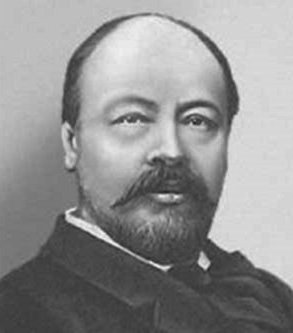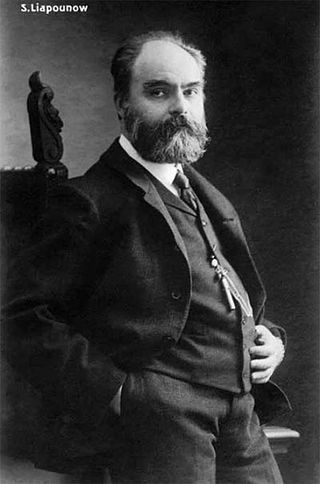Related Research Articles
A prelude is a short piece of music, the form of which may vary from piece to piece. While, during the Baroque era, for example, it may have served as an introduction to succeeding movements of a work that were usually longer and more complex, it may also have been a stand-alone piece of work during the Romantic era. It generally features a small number of rhythmic and melodic motifs that recur through the piece. Stylistically, the prelude is improvisatory in nature. The term may also refer to an overture, particularly to those seen in an opera or an oratorio.

Charles-Valentin Alkan was a French composer and virtuoso pianist. At the height of his fame in the 1830s and 1840s he was, alongside his friends and colleagues Frédéric Chopin and Franz Liszt, among the leading pianists in Paris, a city in which he spent virtually his entire life.

Anatoly Konstantinovich Lyadov was a Russian composer, teacher and conductor.

Sergei Mikhailovich Lyapunov was a Russian composer, pianist and conductor.
C minor is a minor scale based on C, consisting of the pitches C, D, E♭, F, G, A♭, and B♭. Its key signature consists of three flats. Its relative major is E♭ major and its parallel major is C major.
F-sharp minor is a minor scale based on F♯, consisting of the pitches F♯, G♯, A, B, C♯, D, and E. Its key signature has three sharps. Its relative major is A major and its parallel major is F-sharp major.
D-sharp minor is a minor scale based on D♯, consisting of the pitches D♯, E♯, F♯, G♯, A♯, B, and C♯. Its key signature has six sharps.
F minor is a minor scale based on F, consisting of the pitches F, G, A♭, B♭, C, D♭, and E♭. Its key signature consists of four flats. Its relative major is A-flat major and its parallel major is F major. Its enharmonic equivalent, E-sharp minor, has six sharps and the double sharp F, which makes it impractical to use.
B-flat minor is a minor scale based on B♭, consisting of the pitches B♭, C, D♭, E♭, F, G♭, and A♭. Its key signature has five flats. Its relative major is D-flat major and its parallel major is B-flat major. Its enharmonic equivalent, A-sharp minor, which would contain seven sharps, is not normally used.
A-flat minor is a minor scale based on A♭, consisting of the pitches A♭, B♭, C♭, D♭, E♭, F♭, and G♭. Its key signature has seven flats. Its relative major is C-flat major, its parallel major is A-flat major, and its enharmonic equivalent is G-sharp minor.

Grande sonate: Les quatre âges, Op. 33, is a four-movement piano sonata by Charles-Valentin Alkan. The sonata's title refers to the subtitles given to each movement, portraying a man at the ages of 20, 30, 40, and 50. The work was published in 1847, dedicated to the composer's father, Alkan Morhange.
Trois morceaux dans le genre pathétique Op. 15 is a three-movement suite for piano composed by the French composer, Charles-Valentin Alkan, published in 1837. The suite also bears the title Souvenirs (Memories). The 3 movements are Aime-moi, Le vent, and Morte.
Esquisses (Sketches), Op. 63, is a set of 49 short piano pieces by French composer Charles-Valentin Alkan and published in 1861. The pieces are divided into four books; the first pair of books and the last pair each comprise between them pieces in each of all the major and minor keys. Book 4 ends with an extra, unnumbered, piece, Laus Deo, in C major. Four pianists have recorded the set in its entirety: Laurent Martin, Osamu Nakamura, Steven Osborne, and Yui Morishita (twice).

There is a long tradition in classical music of writing music in sets of pieces that cover all the major and minor keys of the chromatic scale. These sets typically consist of 24 pieces, one for each of the major and minor keys.
Sergei Rachmaninoff wrote a number of preludes, all for solo piano. His most important works in this genre are the 24 preludes that cover all 24 major and minor keys. These were, however, written and published at different times, not as a unified set. Of all the composers who wrote sets of 24 pieces in all the keys, Rachmaninoff seems to be the only one who did not originally set out with such a goal in mind. There is not an order to the tonalities of the preludes, like that seen in Bach or Chopin's preludes Rachmaninoff also wrote three other individual preludes.
References
- ↑ Robert Rimm (2002). The Composer-pianists: Hamelin and The Eight. Hal Leonard Corporation. pp. 28–29. ISBN 978-1-57467-072-1.
- ↑ Eddie, William Alexander. (2007). Charles Valentin Alkan : his life and his music. Aldershot, Hampshire, England: Ashgate. p. 100. ISBN 978-0-7546-8404-6. OCLC 648340383.